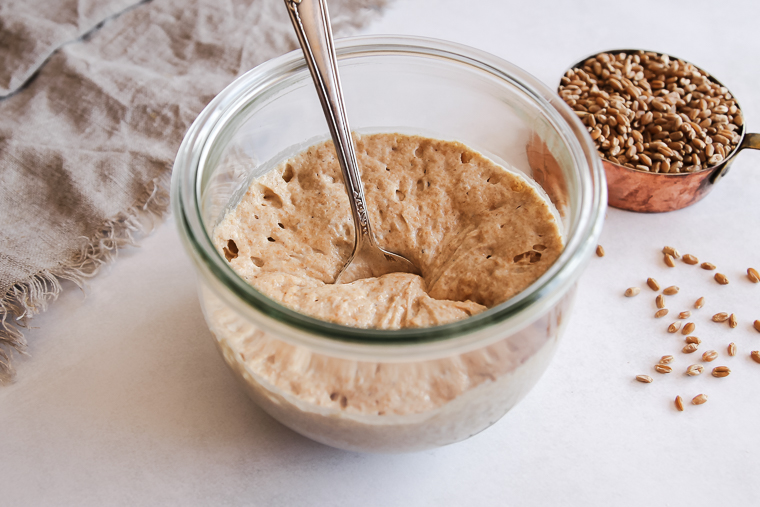
This post may contain affiliate links. See my full disclosure. As an Amazon Associate, I earn from qualifying purchases.
Learn how to make and maintain a sourdough starter with 100% whole wheat flour and water. Then use it to naturally leaven your homemade wholegrain breads! You’ll find this guide especially useful if you’re making your own freshly milled flour.

What is a Sourdough Starter?
A sourdough starter is flour that has been fermented into a living culture of wild yeasts and lactic acid bacteria. It’s used to leaven bread naturally without commercial yeast.
It’s refreshed with new flour and water before baking and used after it has risen. A little starter is always reserved to store and use the next time.
Any type of bread from soft sandwich bread, to English muffins and hamburger buns, can be naturally leavened with sourdough starter.
Sourdough is the old-fashioned way to make bread, and the long rise times required in sourdough baking only affect bread for the better as far as health and flavor benefits go.
A starter becomes a lasting part of the kitchen to be shared and even passed down.

Many sourdough experts recommend unbleached all-purpose flour for the creation and maintenance of a sourdough starter.
This is because, for many people, all-purpose flour is the most affordable and practical option since they are baking with the flour already.
It is true that a bit of white flour starter can be fed with any whole grain flour in preparation for a bake (called a preferment or levain).
If an all-purpose flour starter would best meet your needs, visit this tutorial.
For those that prefer to bake exclusively with whole grain flour, and especially home ground flour, a whole wheat sourdough starter is the way to go!
Differences Between a White Flour Starter and A Starter With Whole Wheat Flour
White flour starters and whole wheat sourdough starters are actually very similar to create and maintain. There are a few differences we can note:
- A whole wheat starter has a higher nutritional profile than a white flour starter. It brings a higher percentage of whole grains to a bake.
- The starter will take on the color and flavor of the flour that is used. A whole wheat starter will be more robust in color and flavor than a white flour starter.
- Depending on the whole wheat flour used, the starter may have a thicker consistency than a white starter when the same feeding ratios are used. There is no need to add additional water.
- Whole wheat sourdough starter typically rises less high in the jar at its peak rise and has smaller bubbles than a white flour starter. This is either because the whole wheat flour doesn’t have the same gluten-forming ability as white flour, or because the bran remaining in the flour cuts through the gluten network, inhibiting rise. Thankfully, ripeness can be judged by other characteristics as well.
- Whole wheat starter rises quicker than white starter and stays at its peak for less time before over-ripening. This is because the enzymatic activity is increased when the bran, germ, and oils remain in the flour.


Can I Convert a White Flour Starter to a Whole Wheat Starter?
Yes! You can easily convert a white flour starter to a whole wheat starter. If you already have a white starter or can get some from a friend, you won’t need to make a new starter.
To convert the starter, simply change the flour you’re feeding with.
Don’t worry if the starter acts a little sluggish at first. After a few peak-to-peak feeds, your starter will be converted and have adjusted to the new flour.
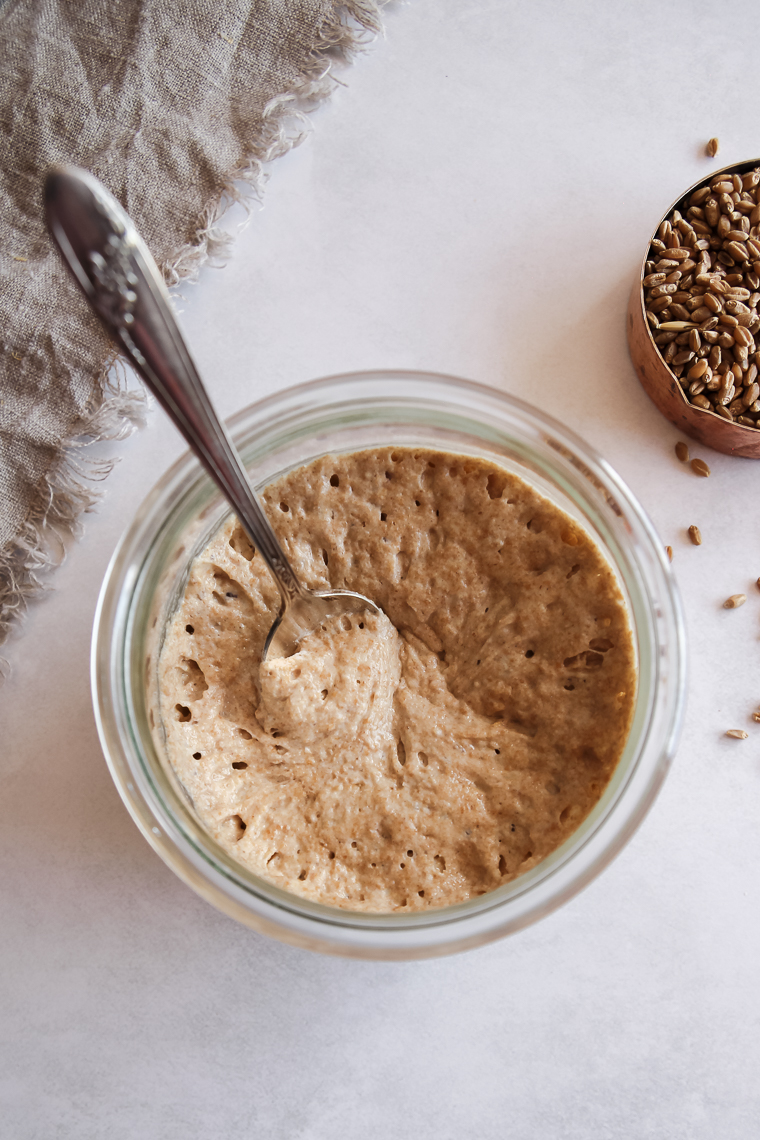
Which Whole Wheat Flour Should I Use For a Sourdough Starter?
So which whole wheat (wholemeal) flour is best for a sourdough starter? Any flour will work.
Use the flour (or variety of wheat berries) that is most affordable for you to purchase. You’ll also want the starter to be versatile for you to use in different recipes.
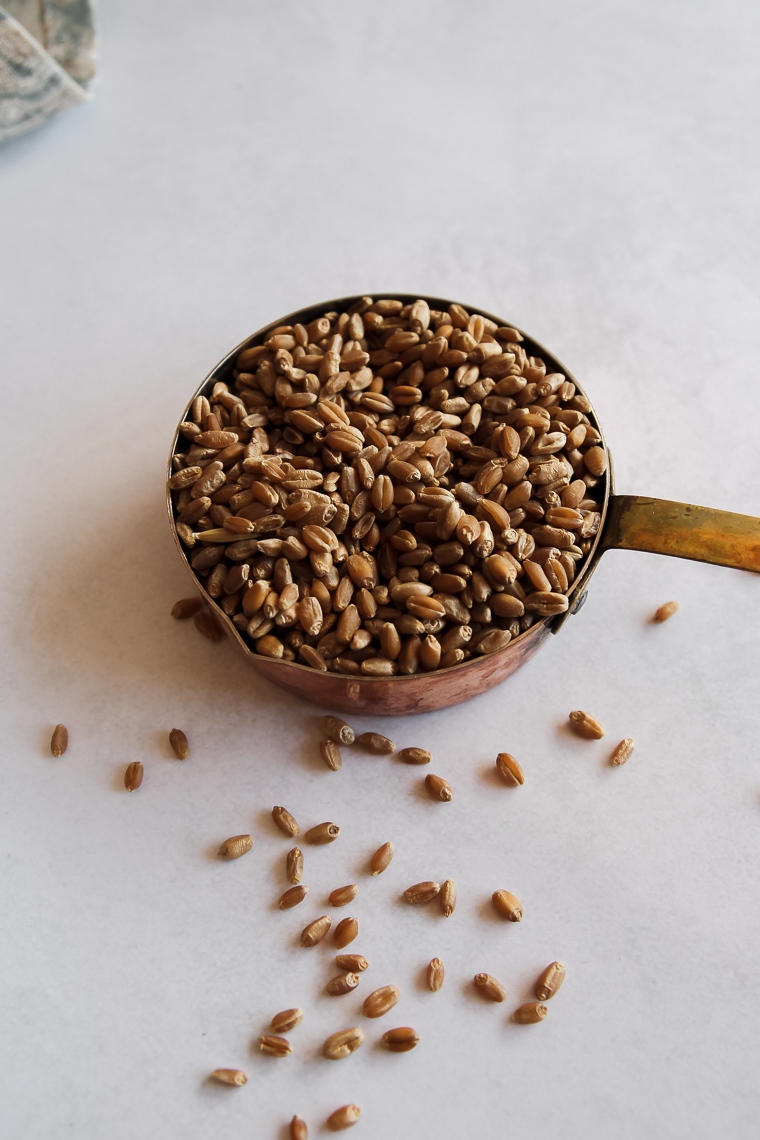
For me personally, I like to use flour I mill from organic hard red or hard white wheat berries.
You could also choose an ancient grain. Use whole khorasan, whole spelt, or whole einkorn if you’re predominately baking with any of those.
Or you can use whole rye, which is technically a pseudo-wheat.
If you’d like to learn to mill your own flour home, visit this beginner’s guide. If you’re purchasing flour, I would suggest choosing a stone-ground flour.
Recommended Supplies to Start or Maintain a Sourdough Starter
You only need a few supplies to start and maintain a whole wheat sourdough starter.
1. Lidded Jar
First, you need a container for your starter. You can use any lidded glass, stoneware, or plastic food storage container with straight walls and a wide mouth. Choose a container that will give your starter room to double after a feed. This way it won’t overflow as it rises.
A loose lid will protect your starter from drying out, molding, or insects, and also allow gasses to escape.
After years of baking sourdough, I have settled on Weck jars as my favorite vessels for my starter.
I love the tulip-shaped ones (pictured) as well. These esthetically pleasing jars have a very wide mouth which makes adding flour, stirring, and taking out starter so easy.
The glass lid can be used without the gasket and clips. The lid will protect the starter while keeping pressure from building up in the jar. And since the jars have no threading at the top, they are very easy to wash.

2. Digital Kitchen Scale
Gram weights are more consistent than cup measurements for feeding a starter and baking sourdough bread. It’s arguably more simple to weigh instead of measure as well.
My favorite scale isn’t the cheapest one out there. I love it because it doesn’t clear itself out mid-weigh or while I walk away to grab something.
It’s sensitive enough that I can set a substantial bowl of dough on top. Then I can weigh in something light like salt. It’s still easy to see the screen with a large bowl on top.
3. Silicon Jar Spatula
My favorite tool for stirring a starter is a sturdy silicon jar spatula. It makes it so easy to get the sides of the jar clean while stirring. There’s no risk of breaking the glass, and it rinses clean easily.
Tips for Making a Whole Wheat Sourdough Starter
- There is no need to sanitize your jars or stirring utensils. Just insure you wash away any soap or detergent residue.
- Unchlorinated water is the best choice, but some people will have no issues using tap water.
- The speed of initial fermentation (and later the mature starter ripening/rising after a feed) is directly related to temperature. 75°F (23°C) is an ideal room temperature, and I call for lukewarm water to keep the starter warmer. If you’re creating a starter during a chilly time of year, the process can take longer than 7-10 days. Give a new starter the time it needs to become established before you attempt to bake with it.
- A starter should always be fed at least its own weight in fresh flour. Discarding during the creation stage is necessary to avoid making a huge starter and wasting flour. You can “build up” the starter later when it’s mature. Do not bake with the discard until the starter is showing signs of maturity (after 7-10 days). Harmful bacteria may be present before the PH balances at maturity.
How to Make a Whole Wheat Starter From Scratch (Step-by-Step Instructions)
It’s quite simple to make a starter from scratch with only flour, water, and time.
As an overview, we will begin by stirring a small portion of flour and water together. The first couple days we only stir the starter once a day while we wait for signs of fermentation.
On the morning we finally see bubbling and rising (usually day 3), we will remove and discard a portion of the new starter and feed it with fresh flour and water. We will continue this feeding cycle once daily until the starter is mature and strong enough to leaven bread.
Morning of Day 1 – Initial Mixing
To begin, place a clean jar on a digital kitchen scale and tare the scale to zero. Weigh in 50g of whole wheat flour and 50g water.
Note: When a starter is fed with equal grams flour and water, it is a “100% hydration starter.” This is the most common hydration needed for sourdough recipes.


Stir the flour and lukewarm water until well combined. Place the lid on the starter and set it in a warm place until the next morning.
Morning of Day 2 (No Signs of Fermentation Yet) – Stir Only
The morning of day 2 you will likely not see any bubbling or rising yet. (If you do, move on to day 3 instructions.) You might see some water on the surface that has separated from the starter.

Simply stir the starter, cover, and leave it until the next morning.
Morning of Day 3 (Showing First Signs of Fermentation) – First Feeding
If you still see little activity on day 3, stir and cover again until the next day. More likely, though, you will see dramatic bubbling on this day. If so, it’s time to begin a once-daily feeding.
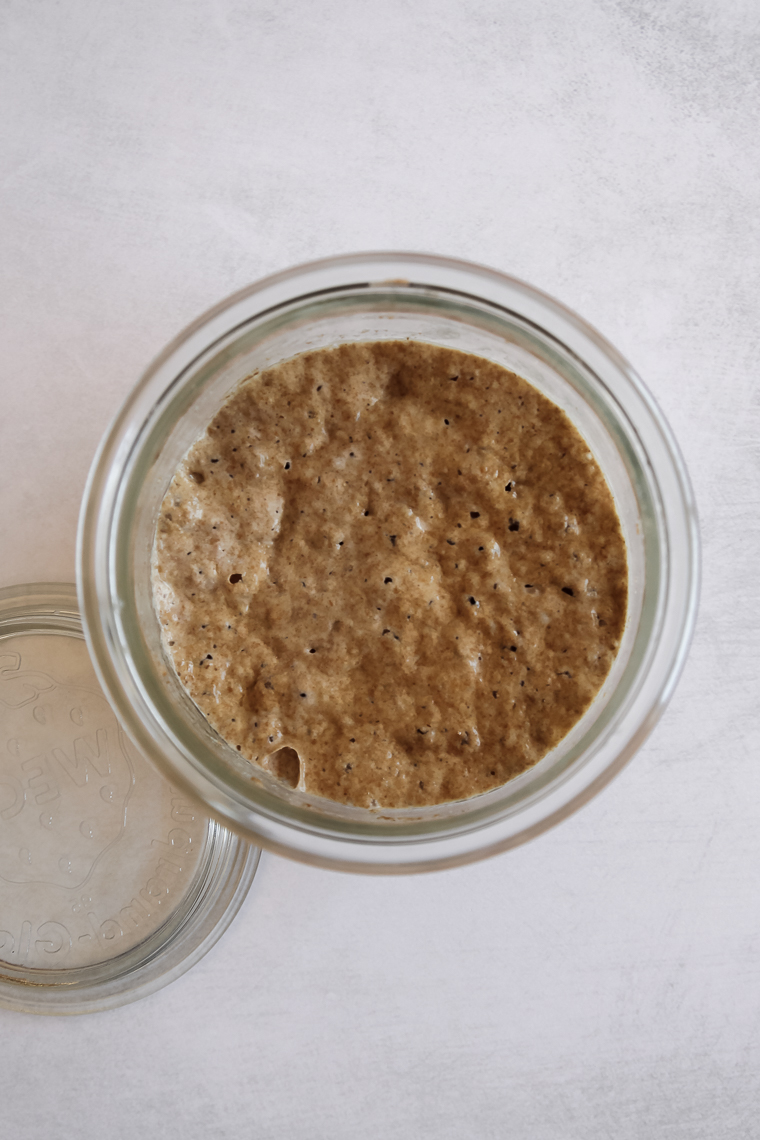
New starters will typically have a burst of activity at about day 2 or 3 with lots of rising and bubbling. This does not indicate a starter is ready for baking. It’s only a misleading rise caused by the bacteria in the starter.
Any time a starter is fed, it needs to receive at least its weight in new flour.
We will discard some starter at each feeding to reduce waste. After the starter is established, we can bake with the extra starter. No discarding will be necessary.
Remove 50g of starter and discard into the trashcan or in the compost. Feed the remaining starter in a clean jar with 50g of fresh whole wheat flour and 50g of lukewarm water. Stir well and cover.
Don’t ever put discard down the sink drain.
Mornings of Days 4-7 (Or Additional Days Until Maturity) – Discard and Feed Once Daily
Mornings 4-6 you may see less activity. This can feel disconcerting after the action on day 3, but this is normal!
It’s also normal for the starter to have an unpleasant smell on these days. It could smell like gym socks, smelly cheese, vinegar, or vomit.
Each of these mornings, discard 100g of starter, leaving 50g in a clean jar. Then feed with 50g fresh flour and 50g lukewarm water. Stir and cover.
If your house is particularly chilly (below 70°F (21°C) or so), you should wait to discard and feed until you actually see bubbling.




I like to mark the starting point so it’s easy to see how much the starter rises. You can use a rubber band on the outside of the jar or mark the jar with a dry-erase marker.
By day six, you might even see some slide marks on the sides of the jar if the starter rose and fell overnight.
You should not do any extra daily feedings during the creation stage. It’s not a problem if your starter is rising and falling early or water is separating to the top of the starter.
By day 7 or so, the starter will likely begin to show signs of a mature starter. It will have a sweeter smell like yeast or fresh bread and will consistently bubble and rise after a feeding.
It’s quite normal if you need to continue this once-daily feeding at least through day 10 and maybe even longer while your starter strengthens.

How to Know When a New Starter Is Mature
Your starter should be a minimum of 7 days old before it’s strong enough to leaven bread. It should also show the following signs:
- It consistently doubles in size 2-6 hours after a feeding (depending on temperature). It should have many small bubbles throughout and an airy texture at its peak rise.
- It has a sweet, pleasant, bread-like aroma with a hint of sourness at its peak rise.
If it’s showing these signs of maturity, you can switch to a regular maintenance routine (see below).
How to Know a Starter Is Ripe After a Feeding
Without experience, it can be challenging to know when a whole wheat starter is actually at its peak rise for baking.
There are a few clues to know when your starter is ripe after a feeding. You should see small bubbles throughout the starter, and even on the top surface. The top should be flat all the way to the edges of the jar. It should smell like yeast with a hint of sourness instead of like raw flour.


This is the point of ripeness when you should use it in a recipe, place it in the refrigerator for next time, or re-feed.
How to Maintain a Mature Whole Wheat Sourdough Starter
Unless you’ll be baking daily, you’ll want to store your starter in the refrigerator between bakes to reduce unnecessary feedings. Feed it at least once a week.
If you’ll be leaving it out at room temperature, it will require peak-to-peak feedings to stay healthy (usually once or twice daily).
I have a post here with all the information you need to feed and care for your starter properly.
How To Tell If Sourdough Starter Has Gone Bad
Starters are very resilient.
Although your starter may have stalled, the chance is low that you’ve actually killed it. It’s more likely that it just needs continued consistent feedings, a warm environment, and more time to mature.
Excessive Heat or Mold
If you see fuzzy black or colorful mold in your starter, then you would have to throw the starter away (this is uncommon, though). Sanitize your jars and utensils and start again. Insure you use a suitable cover for your starter.
Don’t confuse oxidation on the surface or little brown flecks of bran in the whole wheat flour as mold.
A mature starter can also get gray or brown liquid on the surface when it’s neglected. This is an alcohol layer called “hooch” that can be poured off before the starter is refreshed.
Pouring hot water in your starter or accidentally heating your jar of starter to 140°F would certainly kill the yeasts and bacteria you’re trying to cultivate.
A Stalled Whole Wheat Sourdough Starter
If your starter was previously rising well, but has stalled after the first week, you might be feeding it too soon each time. Early feedings will quickly weaken a starter.
Wait to refresh it until it has peaked in the jar or is bubbly throughout, even if you have to wait a couple days. Continue this way until it strengthens again.
Another possibility… your starter may be strong, but is deflating and needing a feeding much earlier than you realize.
In this case, you’ll notice streaks higher on the jar where your starter was previously sitting. The starter fell as it over-ripened and ran out of food. To solve this problem, it may be ready to go in the fridge or be fed more frequently.
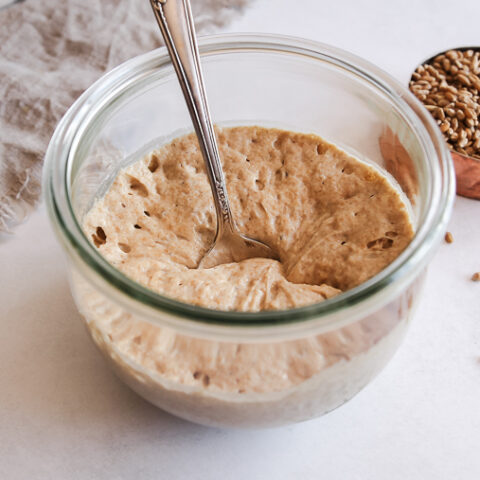
Whole Wheat Sourdough Starter From Scratch
Make your own sourdough starter with 100% whole wheat flour, water, and time. Then use it indefinitely to naturally leaven your homemade wholegrain breads!
Ingredients
- Whole wheat flour (see notes)
- Lukewarm water (unchlorinated is recommended)
Instructions
Morning of day 1 (initial mixing): Set a clean jar (1/2 liter or larger) on a digital kitchen scale and press "tare" to clear the scale to zero. Weigh out 50 grams whole wheat flour and 50 grams of lukewarm water. Stir to combine. Cover with a loose lid and set in a warm place, ideally 75°F (23°C), until the next morning.
Morning of day 2 (no signs of fermentation yet): If bubbling and rising, move on to day 3 instructions. Otherwise, stir the starter, cover, and set it a warm place until the next morning. (Some water separation is normal.)
Morning of day 3 (showing first signs of fermentation): If starter still hasn't bubbled and risen, repeat day 2 instructions. If bubbly, perform the first feeding. (A dramatic rise is common on day 3, but doesn't indicate maturity at this point.) Discard 50g of starter into the trash or compost (leaving 50g in a clean jar). Add 50g fresh flour and 50g lukewarm. Stir well, cover, and place in a warm spot until the next morning.
Mornings of days 4-7 (or additional days until maturity): Continue with a once daily feeding each of these days. If your kitchen is particularly chilly, below 70°F (21°C), wait to discard and feed until you actually see bubbling. Discard 100g starter (leaving 50g in a clean jar), then feed with 50g fresh flour and 50g lukewarm water. Stir well, cover, and leave it in a warm place until the next day. (Some days of little activity and foul smells like stinky cheese, gym socks, or vomit are normal while the starter develops.) Do not feed more than once a day even if starter begins to rise and fall early.
How to tell your starter is mature: If mature (and 7 days old at the very least), the starter should consistently rise every 2-6 hours after a fresh feeding, get bubbly throughout with an airy texture, and have a sweet, yeast-like smell with a hint of sourness (instead of a foul smell like before). You may now use it for baking, build it up with a larger ratio of flour and water if you need to, and transition to a normal maintenance schedule.
Use the starter for baking at its peak rise after a feeding (or refrigerate for another time, or discard and feed again). You'll know your starter is at its peak if the surface has flattened to the edges of the jar, it has bubbled throughout and all the way to the surface, and the smell has changed from raw flour to a bread-like smell.
Unless you'll be baking daily, store your starter in the refrigerator between bakes to reduce unnecessary feedings. Feed it at least once weekly. If you'll be maintaining it at room temperature, it will require peak-to-peak feedings. For more information, see my blog post How to Feed and Maintain a Sourdough Starter.
Notes
Whole wheat flour options: Any kind of store-bought stone ground whole wheat (wholemeal) flour or unsifted freshly-milled flour works well. You can use hard red or hard white wheat, whole spelt, whole einkorn, whole khorasan, or even whole rye (a pseudo-wheat), but choose whichever wheat would be most affordable to purchase and most practical for the baked goods you want to make.
Discard: Since a starter must be fed at least its weight in fresh flour, it's necessary to throw away a portion of the starter before each feeding during the creation stage. Otherwise you'll be wasting flour and creating a huge amount of starter! Sourdough starter discard should be used for baking only after starter is mature (which usually takes 7-10 days). Before that point, the PH of the starter isn't balanced and harmful bacteria may be present. Never put discard starter down the sink drain.
Did I kill my starter? Don't use hot water in the starter or heat the starter above 140°F (60°C) or you will kill the yeasts and bacteria you're trying to cultivate. Throw out the starter if any fuzzy black mold or colorful mold is present, but don't confuse oxidation, gray/brown alcohol (hooch) on the surface, or flakes of bran from the flour as mold. If starter stalls after day 7 when it was previously rising and bubbling, insure you're not feeding the starter too early each time before it actually rises and bubbles. Early feedings will quickly weaken the starter. In contrast, if the starter seems to have stalled, yet slide marks are always present on the jar, you starter is rising and falling before you realize it and is hungry. In this case, see my post How to Feed and Maintain a Starter for more information.
Recommended Products
As an Amazon Associate and member of other affiliate programs, I earn from qualifying purchases.
Nutrition Information:
Yield: 1 Serving Size: 1Amount Per Serving: Calories: 0Total Fat: 0gSaturated Fat: 0gTrans Fat: 0gUnsaturated Fat: 0gCholesterol: 0mgSodium: 9mgCarbohydrates: 0gFiber: 0gSugar: 0gProtein: 0g
*Nutrition information is not always accurate.
I’m so grateful for your comments, reviews, and questions! Your star ratings help others discover my recipes, and your feedback helps me make improvements. Thank you for your support!



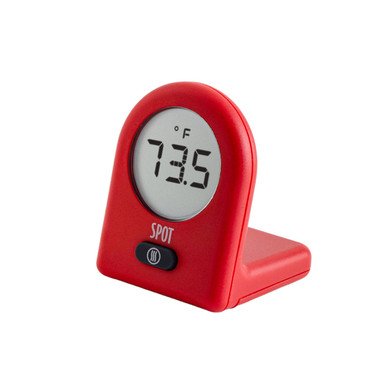





I’ve never seen anyone say in these recipes if you should stir the sourdough starter before you discard. I have been doing this but didn’t really know for sure.
I’m glad the post was helpful, Kathy! Thanks for reading. 🙂